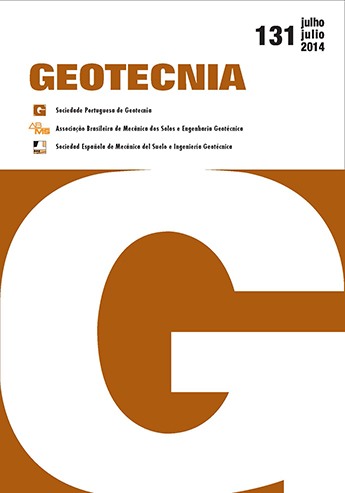Stability analysis of a landfill lined with geosynthetics
DOI:
https://doi.org/10.24849/j.geot.2014.131.02Keywords:
Landfill, Geosynthetics, Stability analysis, Safety factorsAbstract
The design of a landfill requires performing stability analyses. To perform such analyses it is necessary to define different design situations and their corresponding safety factors. Geosynthetics are normally used to build the landfill lining system, and this can cause the existence of critical slip surfaces passing along one of the different geosynthetic interfaces. Determination of the shear strength of such critical interfaces is, therefore, an extremely important issue. In this paper, the convenience of using the peak or the residual shear strength between the different layers of the lining system is analyzed. This analysis is related to the design situations and their corresponding safety factors according to the Spanish codes and the technical literature. As a result of the study, some tables are presented which relate the different design situations (normal, accidental or extraordinary) with the shear strength of the lining system to be used (peak or residual) and the minimum factor of safety to be accomplished is defined. In addition, an example of a stability analysis performed according to the proposed procedure is included.
Downloads
References
Comité Nacional Español de Grandes Presas (CNEGP), 2005. Guía Técnica nº 1 “Seguridad de Presas”.
Estaire, J.; Pardo, F. (2012). Stability analysis criteria in landfill design based on the Spanish codes. 5th European Geosynthetics Congress. Valencia, Septiembre de 2012.
Filz, G.M.; Esterhuizen, J.B.; Duncan, J.M. (2001). Progressive failure of lined waste impoundments. Journal of Geotechnical and Geoenvironmental Engineering, ASCE, Vol. 127, Nº. 10, Oct.: 834-840.
Gilbert, R.B.; Scranton, H.B.; Daniel, D.E. (1997). Shear strength testing for geosynthetic clay liners. Testing and acceptance criteria for geosynthetic clay liners, L. Well (ed.), ASTM, Philadelphia, 55-71.
Koerner, R.M.; Bowman, H.L. (2003). A recommendation to use peak shear strengths for geosynthetic interface design. GFR Magazine. April 2003.
McCartney, J.S.; Zornberg, J.G.; Swan, R.H. (2009). Analysis of a large database of GCL Geomembrane Interface Shear Strength Results. Journal of Geotechnical and Geoenviromental Engineering, ASCE. Vol. 135, Nº. 2, Feb.: 209-223.
Ministerio de Obras Públicas, Transportes y Medio Ambiente (1996). Reglamento Técnico sobre Seguridad de Presas y Embalses.
Stark, T.D.; Poeppel, A.R. (1994). Landfill liner interface strengths from torsional ring shear tests. Journal of Geotechnical and Geoenviromental Engineering, ASCE, Vol. 120, Nº. 3, Mar.: 597- 615.
Subdirección General de Calidad Ambiental (2003). Desarrollo Técnico del Real Decreto 1481/2001 relativo a las instalaciones de vertido de residuos. Rv.07. Documento de Trabajo.
Thiel, R. (2001). Peak vs. residual shear strength for landfill bottom liner stability analyses. Proceedings of the 15th Annual GRI Conference Hot Topics in Geosynthetics - II, Geosynthetics Institute. Folsom, PA: 40-70.




